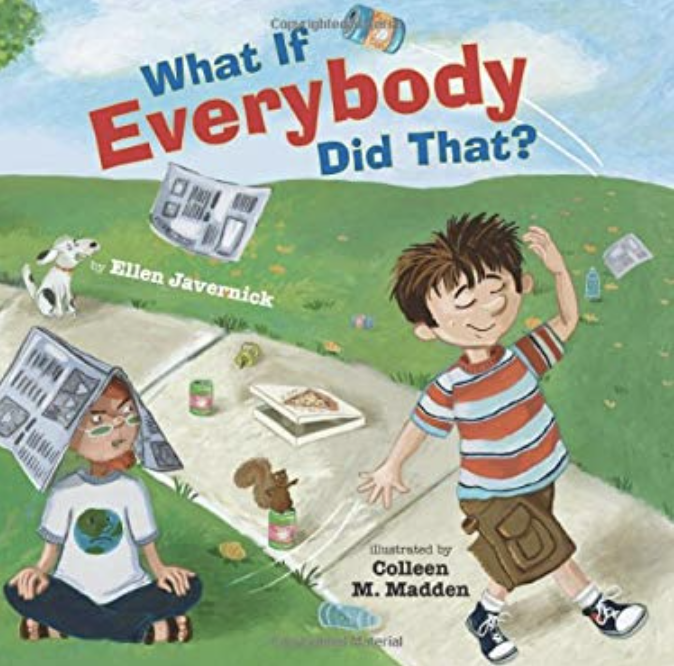What If Everybody Did That?
Book Module Navigation
Summary
What If Everybody Did That? is a story about a clueless young boy who learns the importance of his actions.
The young boy commits several slip-ups that include feeding popcorn to bears at the zoo, tossing a soda can out of a car, and rushing around the grocery store with a shopping cart. With each misbehavior, the boy is scolded by an adult and asked repeatedly, “What if everybody did that?”
Read aloud video by MissEmsBookworm
Guidelines for Philosophical Discussion
Overview
This story’s title is repeated throughout the book as adults respond to misbehavior by asking “What if everybody did that?” It follows the mischievous acts of a boy as he goes to the grocery store, a baseball game, and school. Children are encouraged to think about the collective actions of a community and ask themselves what the consequences might be if all of us were to behave a certain way.
Behave the Way You Want Others to Behave
The story jumps right to the point, showing the boy acting out in public and being asked what the consequences would be if everyone acted like he did. What if everyone littered out of their car window like the boy does in the story? The consequences could be harming wildlife, destroying the environment, and creating an ugly sight to see. While this book was published in 2010, readers will recognize parallels in the story to current events like misbehaving in public or coming together to end the pandemic.
The story offers the opportunity for children to discuss the actions of others and their impact on society at large. We can think about how our actions as individuals can both better the world or make it worse off, and how that action can be made much more significant when we imagine all of us committing it. This focus of the book allows for the discussion of a variety of topics, giving freedom to instructors to apply it in any way that is most accessible to their class.
Questions for Philosophical Discussion
The Consequences of Our Actions and Others’
“It’s okay if we feed the bears a little bit of popcorn… But what if everybody fed the bears?”
- What is the first thing the boy does in the story?
- What happens to the bears when everyone feeds them at the zoo?
- Have you ever done something that you know was bad, but felt wasn’t that harmful?
- Is it ever okay that only one person does something bad, like throwing a soda can out a car window?
- What is the boy doing during story time?
- Why is it important that everyone listen and stay quiet during story time?
- What should we do when someone doesn’t obey the rules, like shooting straws at people in a restaurant?
- What does the boy do at the end of the story?
- While the boy does many bad things throughout the story, how would things turn out if he did good things, like picking up litter instead of throwing it outside?
- Why are rules and routines, like not running with a shopping cart through the grocery store and taking baths, so important for all of us to follow?
Distinguishing between Right and Wrong
- What we do as individuals matters, so how do we ensure we know that what we’re doing is right or wrong?
- What was the boy doing in the grocery store?
- What was wrong with this behavior? How does it affect others in the store
- Does the boy have a responsibility to not act this way in public?
- Why do we follow certain rules in public, like not running in the grocery store?
- At the end of the story, what does the boy do?
- Was there anything wrong with this behavior? How is it different from the other things the boy did in the story?
- Should more people behave this way toward others?
- Why don’t more people do good things, like hug their loved ones or pick up litter when they see it?
- Is it possible for everyone to do good things all the time?
- How is everyone staying quiet during story time different from everyone going out and picking up litter from the street?
Find tips for leading a philosophical discussion on our Resources page.






